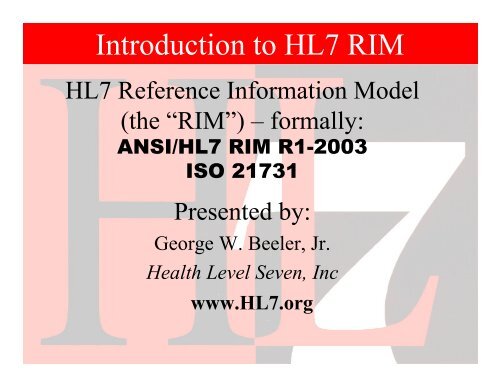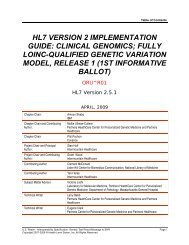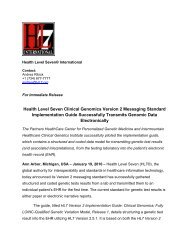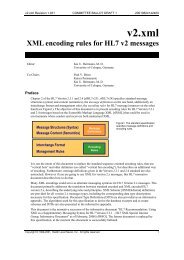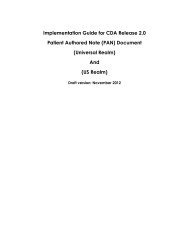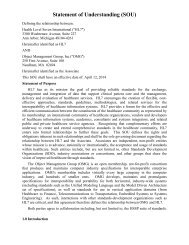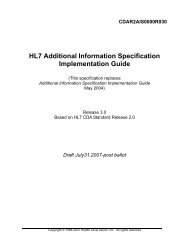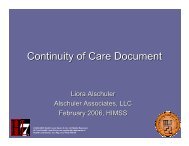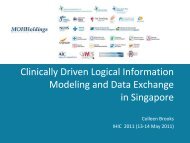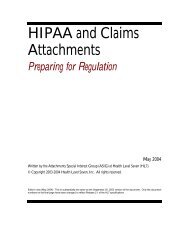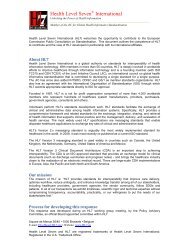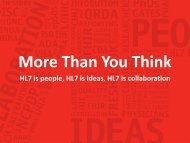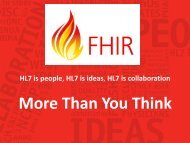Reference Information Model (RIM) - HL7
Reference Information Model (RIM) - HL7
Reference Information Model (RIM) - HL7
You also want an ePaper? Increase the reach of your titles
YUMPU automatically turns print PDFs into web optimized ePapers that Google loves.
Introduction to <strong>HL7</strong> <strong>RIM</strong><br />
<strong>HL7</strong> <strong>Reference</strong> <strong>Information</strong> <strong>Model</strong><br />
(the “<strong>RIM</strong>”) – formally:<br />
ANSI/<strong>HL7</strong> <strong>RIM</strong> R1-2003<br />
ISO 21731<br />
Presented by:<br />
George W. Beeler, Jr.<br />
Health Level Seven, Inc<br />
www.<strong>HL7</strong>.org
<strong>RIM</strong> Milestones<br />
• Concept proposed in 1992 by ANSI/HISPP<br />
Joint Working Group for a Common Data <strong>Model</strong><br />
(in which <strong>HL7</strong> was a key participant)<br />
• <strong>HL7</strong> undertook development formally in 1997,<br />
building on models contributed by members<br />
• Process of Harmonization established to advance the<br />
state of the model<br />
• <strong>RIM</strong> 1.0 (first non-draft <strong>RIM</strong>) – Published Jan 2001<br />
• ANSI/<strong>HL7</strong> <strong>RIM</strong> Release 1 – Approved July 2003<br />
• ISO 21731 (<strong>RIM</strong> Release 1) approved 2006<br />
• <strong>RIM</strong> changed to ANSI “Continuous Maintenance<br />
Process” January 2009<br />
• First Ballot on <strong>RIM</strong> Release 2 opened March 30, 2009
<strong>HL7</strong> – Version 3<br />
• Initial <strong>HL7</strong> standards (Version 2) were based on a<br />
pragmatic ‘just do it’ approach to standards<br />
• <strong>HL7</strong> saw the need to revise and formalize the<br />
process<br />
– to assure consistency of the standards<br />
– to meet plug’n’play demands<br />
– to be able to adopt and leverage new technologies for<br />
both <strong>HL7</strong> and its users<br />
• Adopted the new methodology in 1997<br />
– based on best development & design practices<br />
– supports ‘distributed’ development across committees<br />
– is technology neutral<br />
February 13, 2005 Copyright 2005, <strong>HL7</strong> & Beeler<br />
Consulting LLC<br />
3
<strong>HL7</strong> Version 3<br />
• Methodology based on shared models<br />
– <strong>Reference</strong> <strong>Information</strong> <strong>Model</strong> (<strong>RIM</strong>)<br />
• of the health care information domain<br />
– Defined vocabulary domains<br />
• Drawn from the best available terminologies<br />
• Directly linked to the <strong>RIM</strong><br />
• Supported by robust communication techniques<br />
• Harmonization process that<br />
– Assures each member and committee a voice in the process,<br />
yet<br />
– Produces a single model as the foundation for <strong>HL7</strong> standards<br />
February 13, 2005 Copyright 2005, <strong>HL7</strong> & Beeler<br />
Consulting LLC<br />
4
The “essence” of Version 3<br />
• Apply the ‘best practices’ of software<br />
development to developing standards – a modelbased<br />
methodology<br />
• Predicate all designs on three semantic<br />
foundations – a reference information model, a<br />
robust set of data types, and a complete,<br />
carefully-selected set of terminology domains<br />
• Require all Version 3 standards to draw from these<br />
three common resources<br />
• Use software-engineering style tools to support the<br />
process.<br />
February 13, 2005 Copyright 2005, <strong>HL7</strong> & Beeler<br />
Consulting LLC<br />
5
Class Diagram – Normative <strong>RIM</strong> Release 1<br />
Person<br />
a ddr : BAG<br />
maritalStatusCode : CE<br />
educationLevelCode : CE<br />
raceCode : SET<br />
disabilityCode : SET<br />
livingArrangementCode : CE<br />
religiousAffiliationCode : CE<br />
ethnicGroupCode : SET<br />
LanguageCommunication<br />
languageCode : CE<br />
modeCode : CE<br />
proficiencyLevelCode : CE<br />
preferenceInd : BL<br />
LivingSubject<br />
administrativeGenderCode : CE<br />
birthTime : TS<br />
deceasedInd : BL<br />
deceasedTime : TS<br />
multipleBirthInd : BL<br />
multipleBirthOrderNumber : INT<br />
organDonorInd : BL<br />
NonPersonLivingSubject<br />
strainText : ED<br />
genderStatusCode : CE<br />
Entity<br />
classCode : CS<br />
determinerCode : CS<br />
id : SET<br />
code : CE<br />
quantity : SET<br />
0..n<br />
1 name : BAG<br />
desc : ED<br />
statusCode : SET<br />
existenceTime : IVL<br />
telecom : BAG<br />
riskCode : CE<br />
handlingCode : CE<br />
Entity<br />
Place<br />
mobileInd : BL<br />
addr : AD<br />
directionsText : ED<br />
positionText : ED<br />
gpsText : ST<br />
Organization<br />
addr : BAG<br />
standardIndustryClassCode : CE<br />
player<br />
0..1<br />
scoper<br />
0..1<br />
Device<br />
manufacturer<strong>Model</strong>Name : SC<br />
softwareName : SC<br />
localRemoteControlStateCode : CE<br />
alertLevelCode : CE<br />
lastCalibrationTime : TS<br />
Material<br />
formCode : CE<br />
ManufacturedMaterial<br />
lotNumberText : ST<br />
expirationTime : IVL<br />
stabilityTime : IVL<br />
Container<br />
capacityQuantity : PQ<br />
heightQuantity : PQ<br />
diameterQuantity : PQ<br />
capTypeCode : CE<br />
separatorTypeCode : CE<br />
barrierDeltaQuantity : PQ<br />
bottomDeltaQuantity : PQ<br />
Role<br />
cla ssCode : CS<br />
id : SET<br />
playedRole<br />
code : CE<br />
0..n negationInd : BL<br />
addr : BAG<br />
scopedRole telecom : BAG<br />
0..n statusCode : SET<br />
effectiveTime : IVL<br />
certificateText : ED<br />
quantity : RTO<br />
positionNumber : LIST<br />
Employee<br />
jobCode : CE<br />
jobTitleName : SC<br />
jobClassCode : CE<br />
salaryTypeCode : CE<br />
salaryQuantity : MO<br />
hazardExposureText : ED<br />
protectiveEquipmentText : ED<br />
Role<br />
Access<br />
approachSiteCode : CD<br />
targetSiteCode : CD<br />
gaugeQuantity : PQ<br />
Participation<br />
typeCode : CS<br />
functionCode : CD<br />
1<br />
0..n<br />
target<br />
1<br />
source<br />
1<br />
inboundLink<br />
RoleLink<br />
0..n typeCode : CS<br />
outboundLink effectiveTime : IVL<br />
contextControlCode : CS<br />
sequenceNumber : INT<br />
negationInd : BL<br />
noteText : ED<br />
time : IVL<br />
0..n modeCode : CE<br />
0..n<br />
awarenessCode : CE<br />
signatureCode Participation<br />
: CE<br />
signatureText : ED<br />
performInd : BL<br />
substitutionConditionCode : CE<br />
LicensedEntity<br />
recertificationTime : TS<br />
• 4 Primary Subject Areas<br />
• 35 Classes<br />
• 181 Attributes<br />
• 9 Associations<br />
• 28 Generalizations<br />
Patient<br />
confidentialityCode : CE<br />
veryImportantPersonCode : CE<br />
ManagedParticipation<br />
id : SET<br />
statusCode : SET<br />
PatientEncounter<br />
preAdmitTestInd : BL<br />
admissionReferralSourceCode : CE<br />
lengthOfStayQuantity : PQ<br />
dischargeDispositionCode : CE<br />
specialCourtesiesCode : SET<br />
specialAccommodationCode : SET<br />
acuityLevelCode : CE<br />
ControlAct<br />
Supply<br />
quantity : PQ<br />
expectedUseTime : IVL<br />
Diet<br />
energyQuantity : PQ<br />
carbohydrateQuantity : PQ<br />
WorkingList<br />
ownershipLevelCode : CE<br />
Procedure<br />
methodCode : SET<br />
approachSiteCode : SET<br />
targetSiteCode : SET<br />
PublicHealthCase<br />
detectionMethodCode : CE<br />
transmissionModeCode : CE<br />
diseaseImportedCode : CE<br />
1<br />
Act<br />
classCode : CS<br />
moodCode : CS<br />
id : SET<br />
code : CD<br />
negationInd : BL<br />
derivationExpr : ST<br />
text : ED<br />
statusCode : SET<br />
effectiveTime : GTS<br />
activityTime : GTS<br />
availabilityTime : TS<br />
priorityCode : SET<br />
confidentialityCode : SET<br />
repeatNumber : IVL<br />
interruptibleInd : BL<br />
levelCode : CE<br />
independentInd : BL<br />
uncertaintyCode : CE<br />
reasonCode : SET<br />
languageCode : CE<br />
Observation<br />
value : ANY<br />
interpretationCode : SET<br />
methodCode : SET<br />
targetSiteCode : SET<br />
DiagnosticImage<br />
subjectOrientationCode : CE<br />
Acts<br />
sou rce<br />
1<br />
target<br />
1<br />
ActRelationship<br />
typeCode : CS<br />
inversionInd : BL<br />
outboundRelationship<br />
contextControlCode : CS<br />
0..n contextConductionInd : BL<br />
sequenceNumber : INT<br />
priorityNumber : INT<br />
inboundRelationship pauseQuantity : PQ<br />
checkpointCode : CS<br />
0..n<br />
splitCode : CS<br />
joinCode : CS<br />
negationInd : BL<br />
conjunctionCode : CS<br />
localVariableName : ST<br />
seperatableInd : BL<br />
SubstanceAdministration<br />
routeCode : CE<br />
approachSiteCode : SET<br />
doseQuantity : IVL<br />
rateQuantity : IVL<br />
doseCheckQuantity : SET<br />
maxDoseQuantity : SET<br />
DeviceTask<br />
parameterValue : LIST<br />
FinancialContract<br />
paymentTermsCode : CE<br />
Account<br />
name : ST<br />
balanceAmt : MO<br />
currencyCode : CE<br />
interestRateQuantity : RTO<br />
allowedBalanceQuantity : IVL<br />
FinancialTransaction<br />
amt : MO<br />
creditExchangeRateQuantity : REAL<br />
debitExchangeRateQuantity : REAL<br />
InvoiceElement<br />
modifierCode : SET<br />
unitQuantity : RTO<br />
unitPriceAmt : RTO<br />
netAmt : MO<br />
factorNumber : REAL<br />
pointsNumber : REAL
Action – the focus of health care messaging<br />
• The reason we want to automate health care data is to<br />
be able to document the actions taken to treat a<br />
patient:<br />
– A request or order for a test is an action<br />
– The report of the test result is an action<br />
– Creating a diagnosis based on test results is an action<br />
– Prescribing treatment based on the diagnosis is an action<br />
• In simple terms, a medical record is a record of each<br />
of the individual actions that make up the<br />
diagnosis, treatment and care of a patient.
Five core concepts of the <strong>RIM</strong><br />
• Every happening is an Act<br />
– Procedures, observations, medications, supply, registration,<br />
etc.<br />
• Acts are related through an ActRelationship<br />
– composition, preconditions, revisions, support, etc.<br />
• Participation defines the context for an Act<br />
– author, performer, subject, location, etc.<br />
• The participants are Roles<br />
– patient, provider, practitioner, specimen, employee etc.<br />
• Roles are played by Entities<br />
– persons, organizations, material, places, devices, etc.
1<br />
1<br />
plays<br />
scopes<br />
<strong>RIM</strong> Core Classes<br />
0..*<br />
0..*<br />
Role<br />
Link<br />
0..* 0..*<br />
1 1<br />
0..*<br />
1 0..*<br />
Entity Role<br />
Participation Act<br />
Organization<br />
Living Subject<br />
Person<br />
Material<br />
Place<br />
Patient<br />
Employee<br />
LicensedEntity<br />
Access<br />
1<br />
Act<br />
Relationship<br />
0..* 0..*<br />
1 1<br />
Procedure<br />
Observation<br />
Patient Enc’nt’r<br />
Substance Adm<br />
Supply<br />
Referral<br />
Financial act<br />
Working list<br />
Account
Associations between Roles and Entities:<br />
Downtown<br />
Hospital<br />
Scoped<br />
By<br />
“Played and Scoped”<br />
Joe Smith<br />
Uptown<br />
Hospital<br />
Doctor Patient<br />
Plays<br />
Plays<br />
Scoped<br />
By
Is “Act” sufficient?<br />
• How can a single act class represent all of<br />
the elements of clinical action – their<br />
definition, request, order, report?<br />
• Answer: the Act “mood” code –<br />
“A code specifying whether the Act is an<br />
activity that has happened, can happen, is<br />
happening, is intended to happen, or is<br />
requested/demanded to happen.
Principle Act ‘moods’<br />
definition (DEF) – Definition of an act, formerly a “master file”<br />
intent (INT) – an intention to plan or perform an act<br />
request (RQO) – a request or order for a service from a request “placer” to a<br />
request “fulfiller”<br />
promise (PRMS) – intent to perform that has the strength of a commitment<br />
confirmation (CNF) – promise that has been solicited via an order<br />
event (EVN) – an act that actually happens, includes the documentation (report)<br />
of the event<br />
Critical concept – “Mood” is not a status code. Each instance of the Act class<br />
may have one and only one value for ‘mood’ Thus, an act in “order” mood<br />
that orders an act in definition mood and results in an Act in ‘event’ mood are<br />
three different acts, related through the act relationship.
Abstract<br />
Type known<br />
Mood abstract<br />
Mood code example<br />
Act<br />
classCode : CS = ??<br />
moodCode : CS = ??<br />
id : II = ??<br />
otherAttributes<br />
Observation<br />
classCode : CS = OBS<br />
moodCode : CS = ??<br />
id : II = ??<br />
otherAttributes<br />
Defines a specific<br />
kind of observation<br />
Orders a defined<br />
kind of observation<br />
to be performed<br />
Performs the defined<br />
observation to<br />
fulfill the order<br />
ObservationDefinition<br />
classCode : CS = OBS<br />
moodCode : CS = DEF<br />
id : II = 123<br />
otherAttributes<br />
instantiates<br />
ObservationRequest<br />
classCode : CS = OBS<br />
moodCode : CS = RQO<br />
id : II = O-02-35<br />
otherAttributes<br />
fulfills<br />
ObservationEvent<br />
classCode : CS = OBS<br />
moodCode : CS = EVN<br />
id : II = 7986<br />
otherAttributes
Consider the Act of “Room Cleaning”<br />
• Mood: Proposal<br />
–PRP<br />
• Mood: Order/Request<br />
–RQO<br />
• Mood: Promise<br />
–PRMS<br />
• Mood: Event<br />
–EVN<br />
Why don’t you clean your room<br />
today honey?<br />
Clean your room!<br />
I will already!<br />
Room is cleaned.
1<br />
1<br />
plays<br />
scopes<br />
<strong>RIM</strong> Core Classes<br />
0..*<br />
0..*<br />
Role<br />
Link<br />
0..* 0..*<br />
1 1<br />
0..*<br />
1 0..*<br />
Entity Role<br />
Participation Act<br />
Organization<br />
Living Subject<br />
Person<br />
Material<br />
Place<br />
Patient<br />
Employee<br />
LicensedEntity<br />
Access<br />
1<br />
Act<br />
Relationship<br />
0..* 0..*<br />
1 1<br />
Procedure<br />
Observation<br />
Patient Enc’nt’r<br />
Substance Adm<br />
Supply<br />
Referral<br />
Financial act<br />
Working list<br />
Account
Brief Survey of <strong>RIM</strong><br />
• Basis of <strong>HL7</strong> V3 is single model with only six<br />
back-bone classes and a couple of swedozen<br />
specializations.<br />
• Abstracted by type hierarchies and “mood”<br />
• Displayed on a single 8-1/2 x 11 sheet ---
Entity<br />
<strong>RIM</strong> Core Classes<br />
Role<br />
1<br />
Partic<br />
Act
V3: All About Acts<br />
7
Acts Have Class<br />
• ENC - Encounter<br />
• OBS - Observation (lab)<br />
• SBADM - Substance Administration (pharmacy -admin)<br />
• SPLY - Supply (pharmacy - dispense)<br />
• CLINDOC - Document<br />
Act.classCode :: CS (1..1) Mandatory<br />
Concept domain: ActClass
Acts Can Have Codes<br />
External coding systems:<br />
– Lab Observation Act<br />
Codes could be LOINC<br />
codes.<br />
Acts Have States<br />
Act.statusCode :: SET (0..*)<br />
Concept domain: ActStatus
Acts Have Moods…<br />
• Further clarifies the meaning of the Act (like Class<br />
and Code)<br />
• Specifies if this act is an actual fact (event), or an<br />
intention to perform an act - such as a command,<br />
goal, appointment, or proposal.<br />
• Signifies a major modality or stage for which a<br />
permanent record must be obtained.<br />
• Never changes.<br />
• Alternatively, status can change. Status does not<br />
define the Act.<br />
Act.moodCode :: CS (1..1) Mandatory<br />
Concept domain: ActMood
Acts happen at specific times:<br />
Act.effectiveTime<br />
Definition:A time expression<br />
specifying the focal or<br />
operative time of the Act, the<br />
primary time for which the Act<br />
holds, the time of interest<br />
from the perspective of the<br />
Act's intention.<br />
Data Type = General Timing Specification (GTS)<br />
Similar to V2 TQ repeat interval<br />
Act.effectiveTime :: GTS (0..1)
Types of Act Relationships<br />
• COMP - has component<br />
• PERT - has pertinent info<br />
• SEQL - is sequel<br />
• OPTN - has option<br />
• FLFS - fulfills<br />
• RSON - has reason<br />
• INST - instantiates<br />
• PRCN - has precondition<br />
• OUTC - has outcome<br />
• ARR – arrived by<br />
• SUCC - succeeds<br />
• RPLC - replaces<br />
• OCCR - occurrence<br />
• REFV - has reference values<br />
• AUTH - authorized by<br />
• COST - has cost<br />
• GOAL - has goal<br />
• PREV - has previous instance<br />
ActRelationship.typeCode :: CS (1..1) Mandatory<br />
Concept domain: ActRelationshipType
Participation<br />
• Describes the involvement of an entity in an act.<br />
• The entity is playing a role<br />
(Joe Smith plays doctor).<br />
• The role participates in an act. Examples:<br />
– Author [of an order]<br />
(Ordering Doctor)<br />
– Admitter [of an encounter]<br />
(Admitting Doctor)
Types of Participations<br />
• AUT - author<br />
• ENT - data entry person<br />
• CBC - call back contact<br />
• PATSBJ - patient subject<br />
• ADM - admitter<br />
• PRF - performer<br />
• ATND - attender<br />
• CNS - consenter<br />
• DIS - discharger<br />
• SPC - specimen<br />
• LOC - location<br />
• CON- consultant<br />
• DST - destination<br />
• DEV - device<br />
• TPA - therapeutic agent<br />
• CSM - consumable<br />
• RESPROV - responsible<br />
provider<br />
Participation.typeCode :: CS (1..1) Mandatory<br />
Concept domain: ParticipationType
Next Release of<br />
V3 Data Types<br />
is in FINAL<br />
ballot jointly<br />
by <strong>HL7</strong>, ISO<br />
TC 215 and<br />
CEN TC 251<br />
(April 2009)<br />
Attributes have Data Types<br />
33 V3 Data Types<br />
• ANY<br />
• BL<br />
• BN<br />
• ED<br />
• ST<br />
• CD<br />
• CS<br />
• CO<br />
• CE<br />
• SC<br />
• II<br />
• TEL<br />
• AD<br />
• EN<br />
• TN<br />
• PN<br />
• BAG<br />
• IVL<br />
• HIST<br />
• UVP<br />
• PIVL<br />
• EIVL<br />
• GTS<br />
• PPD<br />
• ON<br />
• INT<br />
• REAL<br />
• RTO<br />
• PQ<br />
• MO<br />
• TS<br />
• SET<br />
• LIST<br />
The Grouping: Data Types:<br />
SET, BAG, LIST, IVL, GTS
Many Attributes also have<br />
Vocabulary Constrains<br />
Expressed as Concept<br />
Domains or Value Sets<br />
AcknowledgementCondition<br />
..<br />
WorkPlaceAddressUse<br />
Coding Strength:<br />
(for attributes with Vocabularies)<br />
CNE = Coded No Exceptions<br />
CWE = Coded With Exceptions<br />
Act.classCode :: CS (1..1) Mandatory<br />
Concept Domain: ActClass (CNE)<br />
bind <strong>HL7</strong> attributes to value sets from external or internal terminologies 8
<strong>RIM</strong>: Food for Thought<br />
• V3 Messages and Documents<br />
are derived from the <strong>RIM</strong><br />
• Other objects could also be<br />
created from the <strong>RIM</strong>.<br />
• Do you have an application for<br />
the <strong>RIM</strong>?<br />
• Some vendors are making their<br />
internal data models consistent<br />
or mappable with the <strong>RIM</strong>.<br />
They are prepared for V3<br />
communication. Are you?
Thank You!<br />
George W. Beeler, Jr., Ph.D.<br />
Emeritus Staff, Mayo Foundation<br />
Principal, Beeler Consulting LLC<br />
807 Tenth Ave. SW<br />
Rochester, MN 55902<br />
(507)254-4810<br />
woody@beelers.com


